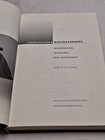Picture 1 of 7







Gallery
Picture 1 of 7







Have one to sell?
Living Pictures, Missing Persons: Mannequins, Museums & Modernity Mark Sandberg
US $50.00
ApproximatelyS$ 65.39
or Best Offer
Condition:
“No dust jacket. No writing inside.”
Oops! Looks like we're having trouble connecting to our server.
Refresh your browser window to try again.
Pickup:
Free local pickup from Bellows Falls, Vermont, United States.
Shipping:
US $4.47 (approx S$ 5.85) USPS Media MailTM.
Located in: Bellows Falls, Vermont, United States
Delivery:
Estimated between Wed, 26 Nov and Wed, 3 Dec
Returns:
No returns accepted.
Coverage:
Read item description or contact seller for details. See all detailsSee all details on coverage
(Not eligible for eBay purchase protection programmes)
About this item
Seller assumes all responsibility for this listing.
eBay item number:227041567978
Item specifics
- Condition
- Good
- Seller Notes
- “No dust jacket. No writing inside.”
- Country of Origin
- United States
- ISBN
- 9780691050737
About this product
Product Identifiers
Publisher
Princeton University Press
ISBN-10
0691050732
ISBN-13
9780691050737
eBay Product ID (ePID)
2304997
Product Key Features
Number of Pages
352 Pages
Language
English
Publication Name
Living Pictures, Missing Persons : Mannequins, Museums, and Modernity
Subject
History / Modern (Late 19th Century to 1945), Europe / Scandinavia, Popular Culture
Publication Year
2002
Type
Textbook
Subject Area
Art, Social Science, History
Format
Hardcover
Dimensions
Item Weight
22 Oz
Item Length
9.2 in
Item Width
6 in
Additional Product Features
Intended Audience
College Audience
LCCN
2002-024345
Reviews
" Living Pictures, Missing Persons is a pioneering work. It gives the first thorough description of the early history of wax museums and folk museums in Scandinavia and it is at the same time a highly interesting analysis of different forms of museum display in light of theories on spectatorship. It is well written, often elegantly combining vivid anecdotal details with theoretical reflection." --Martin Zerlang, University of Copenhagen, "This book stands on its own as the first comprehensive institutional study of wax and folk museums in any national context, and one that, because of the exhaustive nature of the research and the theoretical awareness of the author, succeeds in presenting their multiple forms and roles in ways that go beyond many conventional studies of the era's museums and spectacles." --Anthony Vidler, University of California, Los Angeles
Dewey Edition
21
Illustrated
Yes
Dewey Decimal
948/.07
Table Of Content
LIST OF ILLUSTRATIONS vii ACKNOWLEDGMENTS xiii CHAPTER ONE: The Idea of Effigy 1 CHAPTER TWO: Upstairs, Downstairs at the Wax Museum 18 A Scandinavian Panoptikon 26 Ape in the Human 29 CHAPTER THREE: The Wax Effigy as Recording Technology 37 Annihilation of Space and Time 40 Effigy as Index 47 Persuasive Relics 59 CHAPTER FOUR: Figure and Tableau 69 Showing Stories 71 The Living Tableau 82 Toeing the Line 95 Entrapment Scenarios 108 CHAPTER FIVE: Panoptikon, Metropolis, and the Urban Uncanny 117 Small Big Cities 119 Urbanity and Orientalism 126 The City in the Mirror 135 CHAPTER SIX: Vanishing Culture 145 Cultural Juxtaposition 153 Tableaux for Tourists 161 Cradle or Grave? 168 CHAPTER SEVEN: Dead Bones Rise 178 Homeless Objects 182 Props 191 CHAPTER EIGHT: Insiders 202 Cohabitation 208 Traces 216 Home, Again 224 CHAPTER NINE: Farmers and Flaneurs 232 Cultural-Historical Intoxication 238 Goldi-Locks 245 Rubes and Gypsies 250 Greater Skansen 255 CHAPTER TEN: Material Mobility 261 NOTES 275
Synopsis
In the late nineteenth century, Scandinavian urban dwellers developed a passion for a new, utterly modern sort of visual spectacle: objects and effigies brought to life in astonishingly detailed, realistic scenes. The period 1880-1910 was the popular high point of mannequin display in Europe. Living Pictures, Missing Persons explores this phenomenon as it unfolded with the rise of wax museums and folk museums in the largest cities of Denmark, Sweden, and Norway. Mark Sandberg asks: Why did modernity generate a cultural fascination with the idea of effigy? He shows that the idea of effigy is also a portal to understanding other aspects of visual entertainment in that period, including the widespread interest in illusionistic scenes and tableaux, in the "portability" of sights, spaces, and entire milieus. Sandberg investigates this transformation of visual culture outside the usual test cases of the largest European metropolises. He argues that Scandinavian spectators desired an unusual degree of authenticity--a cultural preference for naturalism that made its way beyond theater to popular forms of museum display. The Scandinavian wax museums and folk-ethnographic displays of the era helped pre-cinematic spectators work out the social implications of both voyeuristic and immersive display techniques. This careful study thus anticipates some of the central paradoxes of twentieth-century visual culture--but in a time when the mannequin and the physical relic reigned supreme, and in a place where the contrast between tradition and modernity was a high-stakes game.
LC Classification Number
GV1836.S36 2002
Item description from the seller
Popular categories from this store
Seller feedback (586)
- m***s (654)- Feedback left by buyer.Past 6 monthsVerified purchaseBeautiful item! Packaging and shipping perfect! Exactly as described. Great price! Highly recommend this seller! AAAA++++
- a***o (2573)- Feedback left by buyer.Past 6 monthsVerified purchaseFast shipping, Beautifully packaged, Better than described at a Great price - Thank You VERY Much ! AAAA ++++ SELLER !!Vintage Tressy Surprise Party Dress American Character 1960s (#225770338338)
- j***n (556)- Feedback left by buyer.Past monthVerified purchaseSeller is honest and good about reaching out. Very fast shipping and packaged well. Doll as described and pictured. Would purchase from again.

